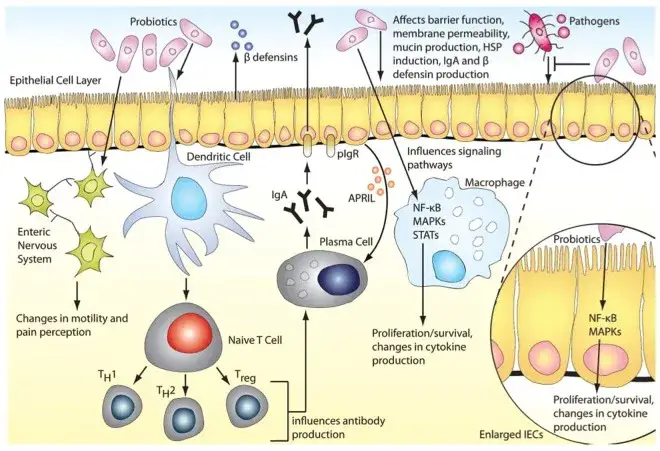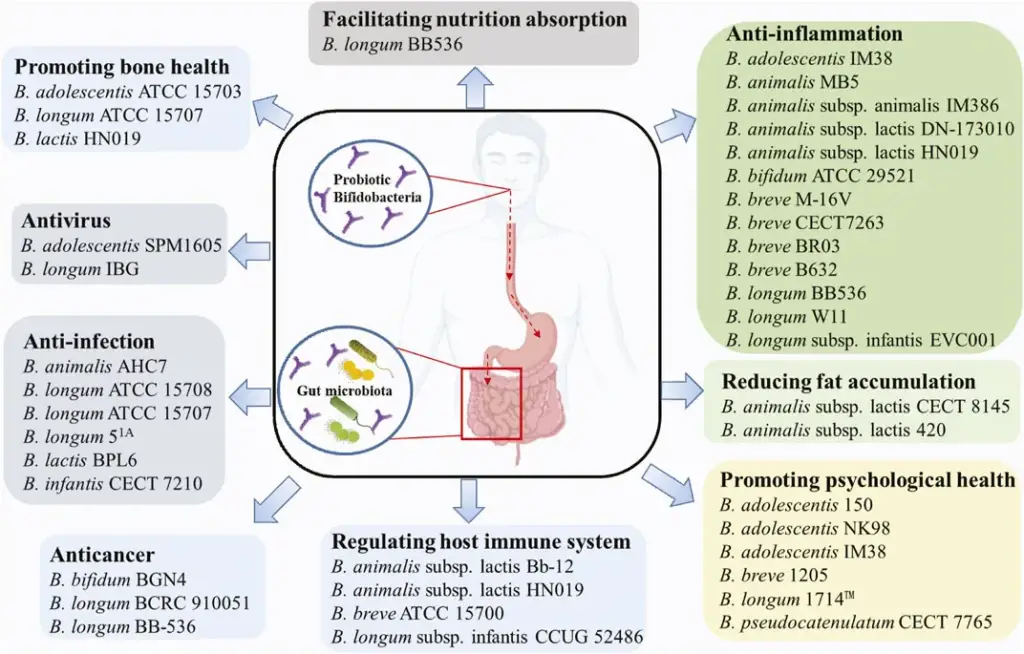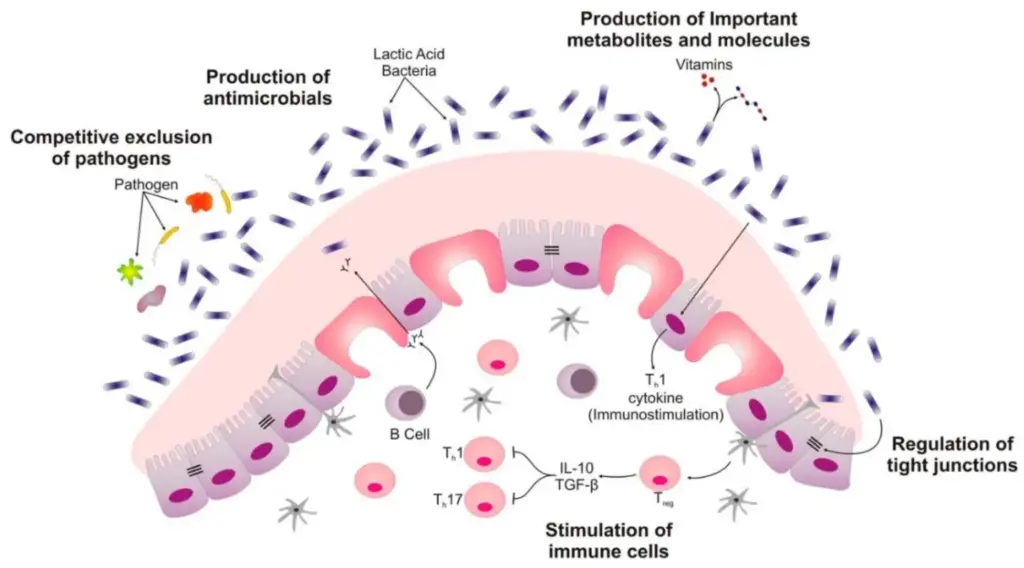Table of Contents
Probiotics Definition
Probiotics are living microorganisms that mitigate the negative effects of antibiotics by restoring the body’s natural homeostasis. Probiotics are identified by their genus, species, and a strain-specific identifying name (e.g. Lactobacillus rhamnosus GG) and are available in a range of formulations, including yoghurt drinks, pills, and nutritional supplements.
- Microorganisms have been part of the human diet for centuries, but the concept of “probiotics” is relatively new. In 1907, the Russian-born Nobel laureate Elie Metchnikoff proposed using helpful bacteria to replace dangerous microbes and pathogens in the human stomach.
- In 1960, Lilly and Stillwell popularised the word “probiotic” by defining probiotics as chemicals produced by microorganisms that encourage the growth of other microorganisms.
- In 1989, Fuller described a probiotic as “a live microbial feed supplement that improves the intestinal equilibrium of the host animal.”
- Another definition, proposed by Havenaar and Huis in’t Veld in 1992, defines a probiotic as “a viable mono or mixed culture of bacteria that, when administered to an animal or human, improves the qualities of the host’s indigenous flora.”
- FAO/WHO 2002 guidelines described probiotics as “live bacteria that, when supplied in suitable quantities, provide a health benefit on the host.” This definition takes into account all current advancements and trends.
- Today, the issue of effective faecal transplants is expected to further alter the notion and future of probiotics as microorganism-mixed cultures.
Probiotic Bacteria
The majority of probiotic bacteria belong to the genera Lactobacillus and Bifidobacterium. Other bacteria and yeasts possess probiotic characteristics as well. Common bacteria include those listed below:
- Lactic acid bacteria (LAB): Genus Lactobacilli spp.; Species: Lactobacillus acidophilus, L. amylovorus, L. brevis, L. bulgaricus, L. casei, L. cellobiosus, L. crispatus, L. curvatus, L. delbrueckii spp. bulgaris, L. fermentum, L. gallinarum, L. helveticus, L. johnsonii, L. lactis, L. paracasei, L. plantarum, L. reuteri, L. rhamnosus; Genus: Streptococcus spp. Species: Streptococcus salivaris spp. thermophiles; Genus: Lactococcus ssp., Species: L. lactis cremoris; Genus: Leuconostoc, Species: Lc. mesenteroides; and Genus: Pediococcus spp., Species: P. pentosaceus, P. acidilactici.
- Bifidobacteria: Genus: Bifidobacterium spp., Species: B. adolescentis, B. animalis, B. bifidum, B. breve, B. essensis, B. infantis, B. laterosporum, B. thermophilum, B. longum.
- Propionibacteria: Genus: Propionibacterium spp., Species: P. acidipropionici, P. freudenreichii, P. jensenii, P. thoenii.
- Enterobacteria: Genus: Enterococcus spp., Species: E. fecalis, E. faecium.
- Sporulated bacteria: Genus: Bacillus spp., Species: B. alcolophilus, B. cereus, B. clausii, B. coagulans, B. subtilis.
- Other bacteria: Genus: Escherichia coli, Species: E. coli; Genus: Sporolactobacillus spp. Species: S. inulinus.
- Yeasts: Genus: Saccharomyces spp., Species: S. cerevisae (boulardii); that isolated from litchi fruit in Indonesia have also been accepted and used as probiotics.
Mechanisms of Probiotics
Competition with pathogens for nutrients and adhesion sites
- Beneficial bacteria hinder the colonisation of harmful pathogens by inhibiting microbial adhesion sites competitively.
- For instance, Lactobacillus casei and Lactobacillus plantarum suppress the adhesion of enteropathogenic Escherichia coli through competitive inhibition.
Inactivation of pathogenic bacterial toxins or metabolites
- Some components of the intestinal microbiota impact the initiation of carcinogenesis by creating enzymes that convert pre-carcinogens into active carcinogens. These enzymes include glycosidase, azoreductase, nitroreductase, and β-glucoronidase.
- Human studies indicate that consumption of L. Volunteers who consume acidophilus or Lactobacillus casei have lower amounts of the aforementioned enzymes in their faeces.
- It has not yet been demonstrated that these probiotic microbes lessen the incidence of cancer.
Production of substances that inhibit pathogen growth
- Antimicrobial organic acids, fatty free acids, ammonia, hydrogen peroxide, and bacteriocins are all produced by probiotic microbes.
- For example, L. casei generates an antibiotic compound with a low molecular weight that inhibits both Gram-positive and Gram-negative intestinal bacteria.
- Probiotics inhibit pathogen growth by stimulating the host’s synthesis of β-defensin and IgA.
Stimulation of nonspecific immunity
- Different probiotics administered orally have demonstrated adjuvant-like effects on intestinal and systemic immunity.
- Several investigations have revealed improved phagocytic activity against intracellular infections and enhanced immunoglobulin A (IgA) responses against pathogenic viruses.
- By maintaining tight junctions and promoting mucin synthesis, probiotics may be able to reinforce the gut barrier.
- According to in-vitro and in-vivo research, probiotics may regulate the immune response by increasing endogenous host defensive mechanisms.
- Various immunological parameters, including humoral, cellular, and nonspecific immunity, can be modified by probiotic microorganisms.
- Enhance the natural killer cell activity in the elderly.
- Causes the formation of mucous.
- Lactobacilli signalling can activate macrophage.
- Stimulate IgA and neutrophil secretion.
- Inhibit the release of inflammatory cytokines and the like.

Observed Health Benefits of Probiotics

Prevention of Dirrhea
- The consumption of probiotic microorganisms such as Lactobacillus rhamnosus GG, Bifidobacterium lactis BB-12, and Lactobacillus reuteri SD2222 significantly reduces the frequency or duration of various diarrheal diseases, including rotavirus diarrhoea.
- Additionally, prophylactic usage among hospitalised children has reduced the risk of nosocomial diarrhoea.
- Among the postulated mechanisms for this protective impact are competitive blockade of receptor sites (leading in suppression of virus adhesion and invasion), stimulation of the host immune system, and synthesis of chemicals that inactivate virus particles.
Reductions of Atopic Diseases (Allergy) in Children
- A clinical investigation demonstrates that administering L. rhamnosus GG to pregnant women for four weeks prior to birth and later to the newborn infant reduced the incidence of early atopic illness significantly.
- Although the precise mechanism has not yet been determined, it is believed that restoration of normal microbiota, augmentation of gut-specific IgA response, and generation of certain cytokines by these organisms may have been responsible.
Decrease in Genitourinary Tract Infections
- The absence of vaginal lactobacilli raises the risk of sexually transmitted infections and the transmission of Neisseria gonorrhoeae and Chlamydia trachomatis.
- Several studies have demonstrated that probiotic lactobacilli reduces the incidence of urinary tract infections, bacterial vaginosis, and candidiasis.
- It has been hypothesised that consumed lactobacilli could climb from the rectal surface to the vagina, or hinder the ascent of infections, albeit the specific mechanism is unknown.
Health Effects
Several clinical symptoms or illnesses have been reported to be positively impacted by the use of certain probiotics, in addition to the good impact of probiotics on overall health. These conditions include diarrhoea caused by gastroenteritis, inflammatory bowel disease, irritable bowel syndrome, Crohn’s disease, and relief of lactose intolerance symptoms.
Effects on Intestinal Disorders
- Probiotics can be used to treat diarrhoea caused by a viral or bacterial infection, as well as antibiotic-associated diarrhoea. Additionally, the effectiveness of probiotic strains varies on the type of diarrhoea.
- For instance, probiotics are beneficial against diarrhoea caused by rotavirus. Saccharomyces boulardii, Lactobacillus rhamnosus, and Lactobacillus reuteri are the predominant probiotic microorganisms utilised in clinical applications with children.
- Some studies highlight the use of Lactobacillus rhamnosus GG in the treatment of Clostridium difficile-associated diarrhoea and the prevention of pouchitis.
- The potential mechanism may be related to an immunomodulatory effect, most likely through an increase in secretory IgA.
- Some probiotic bacteria secrete antimicrobial peptides, or bacteriocins, which may prevent the growth of specific intestinal pathogens.
- It is also believed that probiotic microorganisms compete with pathogens for gut binding sites.
- Inflammatory bowel illnesses, such as Crohn’s and ulcerative colitis, are characterised by heightened immune responses to gut microorganisms. Probiotics have been used to alleviate inflammatory conditions in the gut, which may be attributable to the stimulation of the host immune response, which may include immune cell proliferation, enhanced phagocytic activity, an increase in secretory IgA, and shifts in the overall microbial composition.
- Some lactic acid bacteria, including Lactobacillus delbrueckii subsp. bulgaricus and Streptococcus thermophilus, may also alleviate lactose intolerance by producing lactase.
- For the regulation of lactose intolerance, fermented dairy products such as yoghurt are often suggested. It is hypothesised that, in cases of constipation, lactic acid bacteria release organic acids that change the intestinal microbiota and enhance intestinal motility by decreasing pH or shortening transit time.
Prevention of Allergies
- Probiotics may exert antiallergic effects by destruction or structural alteration of enteral antigens, stabilisation of aberrant microbiota, enhancement of the gut-barrier function, modulation of the release of proinflammatory mediators, and immune system development.
- There is a considerable decrease in the cumulative incidence of eczema and IgE-associated dermatitis, according to trials of probiotic intervention in children. There is additional evidence that probiotic therapy during pregnancy may lessen the risk of eczema in the infant’s first year.
- Infants with food allergies who were fed Lactobacillus rhamnosus GG shown a greater tolerance for cow’s milk protein. Significant roles are played by interactions between gut microbiota and probiotics in immune modulation and allergy susceptibility.
- Furthermore, current understanding implies that individual clinical reports cannot be generalised for general use or as an alternative therapy for allergy treatment. Indeed, attributes are strain-specific, and the precise action mechanisms have yet to be identified.
Anticarcinogenic Activities
- Several probiotic Bifidobacterium spp. strains exist. together with Lactobacillus spp. In several animal models, it was claimed that the compounds have anticarcinogenic, antimutagenic, and antitumorigenic properties.
- Short-chain fatty acids generated by intestinal microbiota have crucial roles in maintaining the health of the colonic mucosa. In contrast to gut bacteria from the clostridial clusters IV and XIVa, however, probiotic strains do not produce anticarcinogenic butyrate.
- Through cross-feeding mechanisms, the latter butyrogenic bacteria may be increased by the introduction of specific probiotics. Butyrate’s anticarcinogenic activity may result from the inhibition of tumour cell proliferation, induction of apoptosis, or differentiation.
- Additionally, probiotics influence carbohydrate and protein fermentation, enriching bacteria with strong saccharolytic and low proteolytic activity.
- End products or metabolites of proteolytic fermentation are potentially hazardous, thus microbial manipulation or dietary alteration toward saccharolytic fermentation is extremely desirable.
- Probiotics, prebiotics, and synbiotics have potential anticarcinogenic activity in humans, but there are very few studies demonstrating their efficacy.
Use of Probiotic in Controlling Blood Cholesterol
- The presence of elevated blood cholesterol levels increases the risk of cardiovascular and other disorders. It has been claimed that the inclusion of probiotics in dietary supplements may aid in cholesterol control.
- Thus, yoghurt containing Lactobacillus acidophilus and Bifidobacterium lactis may reduce serum total cholesterol levels.
- Lactobacilli can precipitate cholesterol from medium and deconjugate bile salts, according to in vitro tests.
- Nevertheless, the cholesterol-lowering capacity may be strain-specific, and human intervention studies are inconclusive.
Why Probiotics?
- When a person’s gut microbial balance is disturbed, probiotics are required. In most cases, gut flora is restored without the need of probiotic supplements, as these beneficial bacteria are present in a variety of foods that we consume on a regular basis, such as fermented milk products (yoghurt and cheese) and fermented food products (kefir, kombucha, tempeh, natto, kimchi, etc).
- In certain instances, doctors may administer probiotic bacteria to restore normal flora.
- There are no formal recommendations for healthy individuals to utilise probiotics. If you wish to try probiotics, see your healthcare professional for guidance on which probiotic to take, how much to take, and for how long.
- a variety of commercial suppliers advertise diverse probiotic products. With so many alternatives available, selecting a probiotic can be difficult.
- Strain-specific identifiers for probiotics comprise genus, species, subspecies (if relevant), and an alphanumeric strain designation. In the probiotic strain Bifidobacterium infantis 35624, for instance, ‘Bifidobacterium’ is the genus, ‘infantis’ is the species, and ‘35624’ is the alphanumeric strain name.
Points to remember while choosing probiotics;
- Only select probiotic strains have proved health advantages. The presence of microorganisms other than those mentioned on product labels may not offer the anticipated benefits.
- Different strains have different benefits. Look for numerous varied strains and their probiotic advantages indicated on the label so you know what you’re getting.
- Not all strains offer significant benefits. Look for strains that have been tested clinically for your specific needs.
- Consuming probiotics may cause infections, bacteremia, sepsis, etc., in immunocompromised persons.
- As probiotics are cultures of living organisms, ensure that these organisms are alive until their expiration date. Improper storage of probiotics may result in the organism’s death, so robbing individuals of their purported benefits.
- Follow the storage directions and the expiration or “use by” date listed on the product’s label. Some probiotics require refrigeration, while others can be maintained at room temperature.
Popular Probiotic Brands
Some of the most popular commercial probiotic brands are as follows;
Align probiotics
- In its formulation, Align uses Bifidobacterium infantis 35624 as a probiotic strain.
- According to the manufacturer, each capsule contains 1 x 109 (1 billion) (4 mg) live bacteria/CFU and offers an effective level of bacteria (1 x 10^7 CFU) when created. This strain of probiotic bacteria promotes and supports a healthy digestive system.
- If your doctor has advised you to take this probiotic, he or she intends to help you restore or build a healthy gut.
- Bifidobacterium is a non-spore-forming, Gram-positive, V- or Y-type branching, rod-shaped, anaerobic bacterium of the family Bifidobacteriaceae and phylum Actinobacteria.
- Strains of Bifidobacterium are used to prevent and cure digestive problems, such as intestinal infections and malignancies.
- Numerous probiotic Bifidobacteria have demonstrated positive effects on humans or animals, including anti-infection, anti-depression, regulation of the host immune system, and nutrient absorption enhancement.
Culturelle probiotics
- Culturelle offers probiotic supplements for gummy bears, infants, children, adults, and women.
- Their composition includes Lactobacillus rhamnosus GG, one of the most scientifically researched probiotic strains that promotes healthy digestion and immunity.
- Lactobacillus rhamnosus GG (LGG) is a probiotic strain that has been investigated extensively and is utilised in a range of commercially available probiotic products.
- This probiotic strain’s documented health advantages include the prevention and treatment of gastrointestinal infections and diarrhoea, the stimulation of immunological responses, and the prevention of some allergy symptoms, among others.
Garden of life probiotics
- To support a healthy microbiome in individuals, Garden of Life’s composition contains a variety of probiotic strains.
- Common probiotic strains discovered in their formulation include Bifidobacterium, Lactobacillus, and Bifidobacterium. reuteri, and L. fermentum.
- They offer a variety of probiotics to meet the diverse health demands of individuals.
- Depending on the nature of the product, their formulation may aid in digestion, boost the immune system, or restore equilibrium to the female external genitalia’s ecology.
- Lactic acid-producing bacteria are the strains of probiotics most widely employed. Lactobacillus fermentum is a Gram-positive, Lactobacillus-genus bacteria.
- It has been discovered that lactobacillus organisms have a significant role in safeguarding the host by enhancing the immune system, enhancing digestion, and lowering metabolic problems. L. fermentum improves the immune response and prevents community-acquired upper respiratory and gastrointestinal illnesses.
- Lactobacillus reuteri is a well-studied probiotic bacteria that is capable of colonising a wide variety of animals. It is also found in various human body regions, including the digestive tract, urinary tract, skin, and breast milk.
- This probiotic bacterium inhibits the severity of enteric illnesses through the production of antimicrobial compounds such as organic acids, ethanol, and reuterin.
- Certain strains of this bacteria affect the immune system by inhibiting the generation of pro-inflammatory cytokines and increasing the formation and activity of regulatory T cells. Studies have shown that direct supplementation or prebiotic modification of L. acidophilus improves intestinal health. reuteri may assist in the prevention or treatment of inflammatory disorders.

ReNew life probiotics
- RenewLife, like any other probiotic company, offers a variety of products to promote digestive health, women’s health, and the immune system.
- The selected probiotic strain may be Bifidobacterium, Lactobacillus, Bacillus (such as B. coagulans or B. subtilis), or a combination of these bacteria, depending on the product type.
GoodBelly probiotics
- GoodBelly Probiotics is formulated with the probiotic strain Lactobacillus plantarum 299v.
- L. plantarum 299v (formerly known as Lactobacillus plantarum 299v) is the most studied strain of L. plantarum strain worldwide It was isolated from the intestinal mucosa of a healthy individual.
- In vitro, animal, and clinical research demonstrate that this probiotic strain supports gastrointestinal health and lowers flatulence and abdominal pain in IBS patients (IBS).
- L. plantarum 299v is stable at room temperature, allowing for lengthy shelf-lives for consumer healthcare goods such capsules, pills, and powder sachets.
- This strain is a good probiotic strain because it can withstand the severe environment of the human gastrointestinal tract.
Other Probiotics
In addition to the probiotics listed above, the following are also widely used:
- Florastor probiotics
- Walgreens probiotics
- Pearl probiotics
- Visbiome probiotics
- Kefir probiotics, and
- Just thrive probiotics

References
- Kumar, H., & Salminen, S. (2016). Probiotics. Encyclopedia of Food and Health, 510–515. doi:10.1016/b978-0-12-384947-2.00570-5
- Islam, J. (2017). Probiotics. Infectious Diseases, 1373–1376.e1. doi:10.1016/b978-0-7020-6285-8.00158-1
- Anadón, A., Martínez-Larrañaga, M. R., Ares, I., & Martínez, M. A. (2016). Probiotics. Nutraceuticals, 777–798. doi:10.1016/b978-0-12-802147-7.00055-3
- Probiotics: facts and myths. Senok, A.C. et al. Clinical Microbiology and Infection, Volume 11, Issue 12, 958 – 966
- Shanahan, F. (2004). Probiotics. Encyclopedia of Gastroenterology, 235–236. doi:10.1016/b0-12-386860-2/00592-x
- Kunes, M., & Kvetina, J. (2016). Probiotics. Nutraceuticals, 799–810. doi:10.1016/b978-0-12-802147-7.00056-5
- Gilliland, S. E. (2003). PROBIOTICS. Encyclopedia of Food Sciences and Nutrition, 4792–4798. doi:10.1016/b0-12-227055-x/00974-3
- You S, Ma Y, Yan B, Pei W, Wu Q, Ding C, Huang C. The promotion mechanism of prebiotics for probiotics: A review. Front Nutr. 2022 Oct 5;9:1000517. doi: 10.3389/fnut.2022.1000517. PMID: 36276830; PMCID: PMC9581195.
- Ayivi RD, Gyawali R, Krastanov A, Aljaloud SO, Worku M, Tahergorabi R, Silva RCd, Ibrahim SA. Lactic Acid Bacteria: Food Safety and Human Health Applications. Dairy. 2020; 1(3):202-232. https://doi.org/10.3390/dairy1030015
- Mu Qinghui Mu, Vincent JT, Luo XM. Role of Lactobacillus reuteri in Human Health and Diseases. Frontiers in Microbiology. 2018;9.https://www.frontiersin.org/article/10.3389/fmicb.2018.00757
- Chen J, Chen X, Loong HC. Recent Development of Probiotic Bifidobacteria for Treating Human Diseases. Frontiers in Bioengineering and Biotechnology. 2021;9. https://www.frontiersin.org/article/10.3389/fbioe.2021.770248
- Fijan S. Microorganisms with claimed probiotic properties: an overview of recent literature. Int J Environ Res Public Health. 2014;11(5):4745-4767. Published 2014 May 5. doi:10.3390/ijerph110504745


